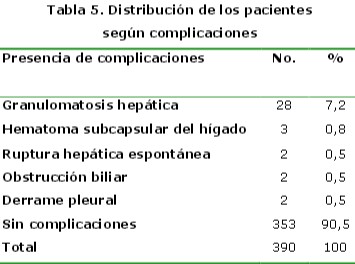Infestación humana por fasciola hepática
Abstract
Se realizó un estudio transversal descriptivo para caracterizar 390 pacientes con fascioliasis hepática procedentes de Esmeralda, Camagüey, durante 1999. Los datos fueron procesados utilizando el programa estadístico Microstad. Predominaron las mujeres con el 56, 4 % de los casos, ubicadas entre los grupos de 31 a 60 años de edad. Los síntomas más frecuentes fueron fiebre, astenia, pérdida de peso y dolor en hipocondrio derecho, mientras que la hepatomegalia fue el principal signo. La eosinofilia estuvo presente en el 97, 6 % del universo; en cuanto a las complicaciones solo el 9, 5 % presentó algunas, entre las cuales la granulomatosis hepática fue la más frecuente (7, 2 %).Downloads

Downloads
Published
How to Cite
Issue
Section
License
Copyright: Camagüey Medical Archive Magazine, offers immediately after being indexed in the SciELO Project; Open access to the full text of the articles under the principle of making available and free the research to promote the exchange of global knowledge and contribute to a greater extension, publication, evaluation and extensive use of the articles that can be used without purpose As long as reference is made to the primary source.
Conflicts of interest: authors must declare in a mandatory manner the presence or not of conflicts of interest in relation to the investigation presented.
(Download Statement of potential conflicts of interest)
The Revista Archivo Médico de Camagüey is under a License Creative Commons Attribution-Noncommercial-No Derivative Works 4.0 International (CC BY 4.0).
This license allows others to distribute, to mix, to adjust and to build from its work, even for commercial purposes, as long as it is recognized the authorship of the original creation. This is the most helpful license offered. Recommended for maximum dissemination and use of licensed materials. The full license can be found at: https://creativecommons.org/licenses/












 22 julio 2025
22 julio 2025